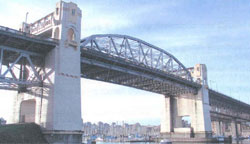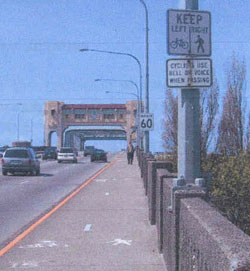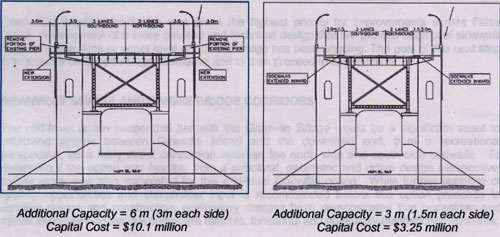False Creek Pedestrian and Cyclist Crossings Study
Vancouver, Canada
Source: Pedestrian and Bicycle Information Center (PBIC)

One of the bridge targeted for pedestrian improvements.

Current pedestrian conditions on a Vancouver bridege.
Problem
An already high rate of nonmotorized morning peak traffic — 11 percent was expected to grow. However, the existing nonmotorized capacity on bridges crossing False Creek would not be able to keep up.
Background
Home to over two million people, Greater Vancouver has consistently been rated as one of the most livable cities in the world. Presently, nonmotorized users are able to cross False Creek into downtown over three high-level bridges, or by private ferry systems. However, between 1996 and 2002 the total number of pedestrian and cyclist trips across False Creek grew by 30 percent, totaling over 8,000 per day. Additionally, the City's target for 2021 is to increase walking and cycling trips from 11 percent to 14 percent of total trips made during the peak period. To achieve this, the city is committed to improving nonmotorized travel capacity, comfort, and safety.
Solution
The City of Vancouver Engineering, Planning, and Park Board led a partnership of over 25 stakeholders in a feasibility and design study to evaluate the need and potential means for improved recreational and commuter crossings across False Creek. The study was to determine the existing and latent nonmotorized demand, develop conceptual designs and preliminary cost estimates, and assess the impacts of alternatives on existing transportation facilities, land use, and communities.
Latent demand was measured by taking traffic counts during a transit strike, which showed a 300 percent increase compared to base conditions. The relative proportions of trip purposes were also determined during the strike: 76 percent commuting to work, 11 percent recreational, and 12 percent for miscellaneous other reasons. Many geographical maps were created to illustrate origin and destination patterns, and to determine relative use of the three different bridges.
At the beginning of the conceptual stage, the public, staff and the consultant team generated over 35 pedestrian and cyclist improvement options that included upgrading existing facilities, creating new crossings, improving accessibility versus adding capacity, and providing recreational versus commuter oriented improvements. Options that were not short listed were kept as potential improvement options to be examined at a future date.
The final five options focused on two of the three bridges, with plans for the third being delayed for a later date. For the Burrard Bridge, options considered were an outward extension of the sidewalk, and inward widening of the sidewalk, or a low level crossing beneath the bridge. For the Granville Bridge, both a mid level crossing beneath the bridge and a reduction in the number of lanes to provide separate bike lanes were considered.
It was determined that despite the higher cost of outward sidewalk extensions over inward sidewalk widening, the former solution would better serve the long term needs of the City by not hampering the capacity of the vehicle travel lanes expanding sidewalk capacity. Additionally, there would be room for a barrier between traffic and nonmotorists to provide greater safety. The low level crossing was determined to be impractical given the frequency with which it would have to be opened to allow boats to pass. Preliminarily, it was determined that the midlevel crossing on Granville Bridge would be the most direct connection between seawalls for recreational cyclists, and would also be the most aesthetically attractive.
The False Creek Pedestrian and Cyclist Crossings Study was completed in just over a year for approximately $100,000, not including staff time.

Results
The study findings were used to develop a short and long term strategy to improve the safety and convenience of pedestrian and cyclist crossings, which included a list of additional studies and capital funding that would need to be accomplished in the future.
Over the long term, it was concluded that it would be worthwhile to do a major crossing enhancement across False Creek in each bridge corridor. The design work completed has helped each corridor move closer towards implementation.
Contact
Dale Bracewell, Transportation Engineer
435 West 12th Avenue
Vancouver, British Colombia, V5Y 1V4
(604) 871-6440
dale_bracewell@city.vancouver.bc.ca
www.city.vancouver.bc.ca
Image Source
Institute of Transportation Engineers Pedestrian Project Award. City of Vancouver. http://www.ite.org/awards/pedproject/ppa085.pdf




